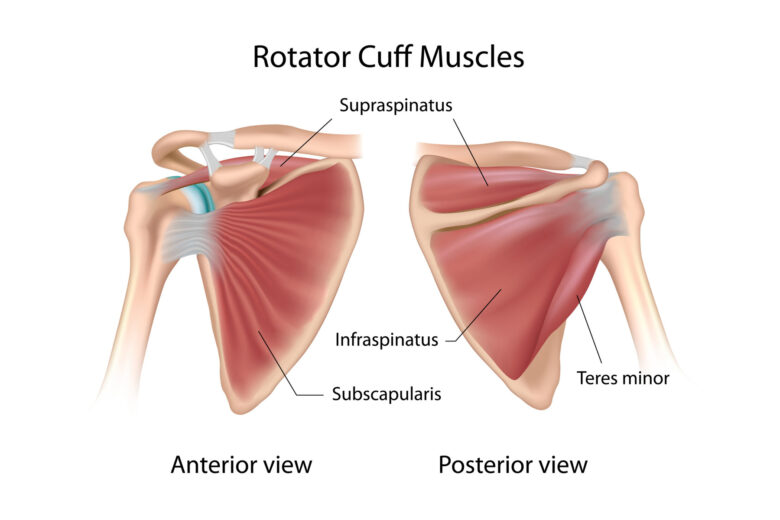Use our convenient online scheduler to book an appointment now.

Rotator cuff tears are prevalent. About 5-40% of people with shoulder pain are thought to have rotator cuff tears. Nearly 2 million doctor visits in the U.S. yearly are due to rotator cuff injuries.
Tears of the rotator cuff describe any disruption of one or more of the rotator cuff tendons of the shoulder. These tears can be complete, occurring through the tendon’s entire thickness. Alternatively, they may also be incomplete (“partial rotator cuff tear“), only occurring through part of the tendon’s thickness.
Rotator cuff tears are more common in those who regularly participate in overhead activities (painters, laborers, athletes, lifting heavy objects, etc.). Their frequency increases with age. About 50% of all people over the age of 60 years old have a rotator cuff tear. In many cases, rotator cuff tears are not symptomatic. They are often found accidentally on MRI studies ordered to look for other causes of shoulder pain.
The following video shows the surgical (arthroscopic) appearance of the normal rotator cuff, followed by a rotator cuff tear.
Understanding Rotator Cuff Tears Through Shoulder Anatomy
The shoulder joint is comprised of shoulder ligaments and tendons. The rotator cuff describes the combined tendon (“cuff”) where four deep shoulder tendons come together on the upper arm (humerus) and surround the shoulder joint. The rotator cuff tendons anatomy begins on the shoulder blade (scapula) as four muscles. The four muscle-tendon groups that make up the rotator cuff are the:
- Supraspinatus
- Infraspinatus
- Subscapularis
- Teres Minor
The Supraspinatus is the most commonly affected of the four. The rotator cuff diagram below shows the location of the muscles.
The shoulder blade is attached to the chest wall by additional muscles. As a result, the rotator cuff indirectly connects the arm to the chest wall through its attachments to the shoulder blade. When the muscles that make up the rotator cuff shorten, there is a pull on the tendon attachment at the upper arm, and this causes the arm to move. This function is impaired when the rotator cuff is disrupted (tear).
Causes of Rotator Cuff Tears
Rotator cuff tears can occur from an acute injury to the shoulder, like during a fall. Alternatively, they can emerge from “wear and tear” of the tendon over time. Slowly developing tears are much more common than acute tears. They develop from pressure on the tendon by nearby bony structures, poor blood supply of the aging tendon, and an accumulation of microdamage over time.
Symptoms of Rotator Cuff Tear
Rotator cuff tears may not always produce symptoms. However, if the tear is large enough, it will disrupt the ability of the rotator cuff to stabilize the shoulder joint. If the tear is small, the patient may not experience symptoms until later. In addition, the symptoms associated with a torn rotator cuff depend upon which portion(s) of the rotator cuff is damaged. For example, the supraspinatus tendon is often injured first because it attaches to the top of the humeral head. It is responsible for stabilizing the shoulder joint against excessive upward rotation. Therefore, patients typically report pain and loss of strength in their arms when trying to raise them overhead. Pain may also radiate down the arm, but usually not below the elbow..
Though symptoms are not always cut and dry, someone with severe pain can experience common issues such as:
- Arm pain at night
- Difficulty sleeping
- Pain when lifting and lowering the arm
- Shoulder weakness
- Stiffness or tenderness in the joint
- Limited range of motion
- Limit in daily activities
No matter the symptoms a patient experiences, seeking proper evaluation from an expert will help with an official diagnosis and treatment options.
Types of Rotator Cuff Tears
There are two main types of rotator cuff tears: partial-thickness tears and full-thickness tears. Partial-thickness tears involve only the superficial fibers of the rotator cuff. Full-thickness rotator cuff tears involve all layers of the rotator cuff, including the superficial, middle, and deep portions.
Partial-Thickness Rotator Cuff Tears
A partial-thickness tear involves damage to the outer layer of the rotator cuff, usually the supraspinatus tendon. A partial tear is less likely to require surgery than full-thickness ones and can often be treated using nonsurgical treatments. However, they still need to be evaluated by a doctor. A partial-thickness tear is most commonly seen in people with repetitive trauma to the shoulder joint.
Full-Thickness Rotator Cuff Tears
A full-thickness rotator cuff tear, or a complete tear, occurs when the entire thickness of the rotator cuff has been compromised. This means the tendon itself is no longer attached to bone. Full-thickness tears are more challenging to treat than partial-thickness ones because they require surgical treatment.
Feel Better. Move Better. Be Better.
Town Center Orthopaedics offers the best providers for orthopedic care to those with rotator cuff injuries. To receive care from one of our orthopedic shoulder surgeons, call (571) 250-5435 or request an appointment.
Join our Mailing List
TCO provides patients with orthopedic problems the trusted resources and patient-centered advice they need to “Feel Better. Move Better. Be Better.”
© 2024 Town Center Orthopaedics | All Rights Reserved


